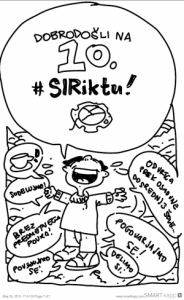Žan Močivnik, I. osnovna šola Celje
Can pupils interact with 400 children from all around the world and present their entrepreneurship and innovation? Our pupils made it happen this year – using their project and robot under the First Lego League – FLL programme. The project developed creativity, curiosity, cooperative learning and teamwork. Pupils got to know the STEM concept (science, technology, engineering and math) through different methods and were introduced to modern technologies in a fun and effective ways to use them for humane purposes. The pupils work was divided into three parts: core values, project (Trash Trek – Smetko sledko) and robot part (composing the robot, programming it, preparing technical documentation). A group of pupils chose the problem of non-sorting of the waste in communities. Their solution was to monitor the sorting of the trash of individuals: making a smart waste disposal zone system which contains a communication device connecting the trash to the barcode scanner, locking the trash bins, using a new trashbag which is also adapted to people suffering from poor eyesight or colour blindness, monitoring the users though an information system. EV3 Lego software was used to create a working model of a waste disposal zone. During their research the pupils met with different plastic experts, smart systems engineers, National Instruments company, the regional waste management centre Simbio and other experts. Their project was nominated for the Global Innovation Award, where only the top 20 best projects compete and present themselves in the USA. Besides the project the pupils used the EV3 Lego set to create their own robot that was one of the best in the world in the robot game together with its skilful programming and attachments. The programming and composing took 4 months to complete. Excellent results qualified the team for the Open European Championship in Spain where 80 teams from 40 countries and 5 continents took part. Pupils work on the project independently, the teacher is only their mentor who encourages them and follows their work. This method is different from our educational system and demands different type of work from pupils – independence, remote work, writing a journal etc. The teacher has more work with constant reports, but the pupils become more independent and acquire experience in working in smaller teams. The ratio between the pupil and the entrepreneur becomes very small, with the quality of knowledge greatly increasing through experience.
